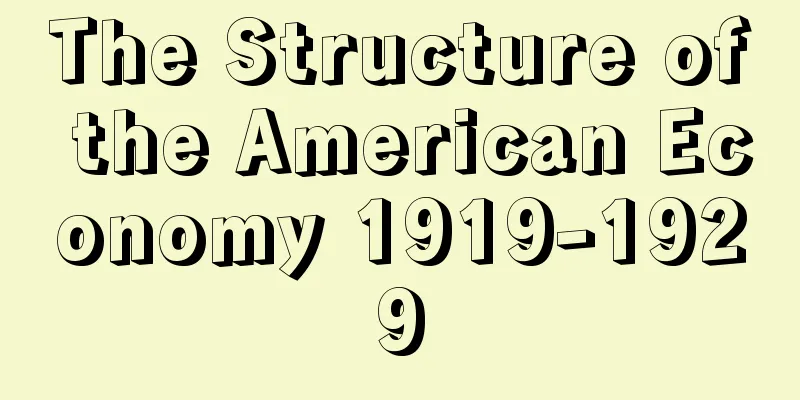The Structure of the American Economy 1919-1929

|
…The percentage of heavy chemical industry in the added value of manufacturing industry is called the heavy chemical industrialization rate, and this percentage tends to rise with economic development. While previous analyses of industrial structure were centered on two-dimensional analysis known as industrial composition theory, WW Leontiev, in his 1941 book The Structure of the American Economy 1919-1929, attempted to grasp the changes in industrial structure in three dimensions using input-output analysis (see the entry on input-output tables). Leontiev was the first to clearly define and analyze the concept of industrial structure. … From Leontief…Russian-born American economist known as the founder of input-output analysis (input-output analysis). Born in Leningrad, he studied economics at Leningrad University. After defecting, he obtained his doctorate at the University of Berlin (1928). He was invited by the Nanjing government of the Republic of China to serve as an economic advisor on railway construction (1929), and in 1931 he moved to the United States and became a lecturer at Harvard University (professor in 1946). From then until he moved to New York University in 1975, he devoted himself to academic and educational activities at Harvard, while also presiding over his own research group, the Harvard Institute of Economics (1948-72), and continuing his original research activities. … *Some of the terminology referenced in "The Structure of the American Economy 1919-1929" is listed below. Source | Heibonsha World Encyclopedia 2nd Edition | Information |
|
…製造工業の付加価値に占める重化学工業の割合を重化学工業化率というが,この比率は経済の発展とともに上昇する傾向がみられる。 これまでの産業構造分析が産業構成論という平面的な分析が中心であったのに対し,W.W.レオンチエフは,1941年に発表した《アメリカ経済の構造1919‐1929》のなかで,産業連関分析(〈産業連関表〉の項参照)の手法を利用して産業構造の変化を立体的にとらえようとした。産業構造という概念を明確に定義し,分析したのはレオンチエフが最初といえる。… 【レオンチエフ】より…投入産出分析(産業連関分析)の創始者として著名な,ロシア生れのアメリカの経済学者。レニングラードに生まれ,レニングラード大学で経済学を学んだ。亡命ののちベルリン大学で博士号を取得(1928)。中華民国南京政府の招きで鉄道建設に関する経済顧問を務め(1929),1931年アメリカに移住してハーバード大学の講師(1946教授)となる。以後75年にニューヨーク大学に移るまで,ハーバードで学会・教育活動に専念する一方,独自の研究集団〈ハーバード経済研究所〉を主宰(1948‐72),独創的研究活動を続けた。… ※「《アメリカ経済の構造1919-1929》」について言及している用語解説の一部を掲載しています。 出典|株式会社平凡社世界大百科事典 第2版について | 情報 |
>>: "Outline of American Economics" - american economics
Recommend
Zero lift angle
…Symmetrical wings and flat plates do not generat...
Ki no Tsurayuki - Snowfall
A poet of the early Heian period. Famous for bein...
Memento division - Katamiwake
The distribution of the dead's clothing and p...
agate snail
...Originating from central East Africa, it sprea...
First - First
〘 noun 〙① The first in order. The first. Number on...
Electronic circuit - denshikairo (English spelling) electronic circuit
An electric circuit using electronic devices. Ele...
Anthraquinone pigment - anthraquinone pigment
It is a high-grade organic pigment derived from an...
Gozanban
A general term for books published mainly by the ...
Summer cypress (English spelling)
…It is widely distributed in the dry regions of t...
Pilgrimage to Kumano - Kumanosankei
〘 noun 〙 = Kumano pilgrimage (1) ※ Heike (before t...
Acupuncture - Shinkyu
Acupuncture and moxibustion. In Chinese medicine, ...
MAD - Mad
Mutually assured destruction : A nuclear strategy ...
Arshile Gorky
American painter. His real name is Vasdanig Manog...
Agrippa D'Aubignè
French poet. Born into a Reformed (Calvinist) ari...
Memory protection - memory protection; storage protection
This refers to protecting the contents of a certai...









